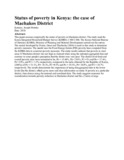| dc.description.abstract | This paper assesses empirically the status of poverty in Machakos district. The study used the Kenya Integrated Household Budget Survey (KlHBS)-2 005/2 006. The Kenya National Bureau of Statistics (KNBS), Ministry of Planning and National Development carried out the survey. The model developed by Foster, Greer and Thorbecke (1984) is used in this study to determine poverty measures. The model uses the Food-Energy-Intake (FEI) poverty lines computed from the KlHBS data to construct poverty measures.
The study results indicate that poverty in rural areas 0/ Machakos district was not high as claimed when using the national aggregated data and contrary to some people's perception that the district was very poor. The district level food and overall poverty rates were estimated to be, Po = 15.49%, Pj= 2.95%, P2 =1% and Po = 37.6%, Pi= 8.9%, and P2 = 3.5% respectively, compared to the rates obtained by the Republic of Kenya, (2007a) of Po = 53.1%, Pi= 19.3%, P2 =9.8% and Po = 58.8%, Pi= 20.9%, and P2 = 10.7% respectively.
The results demonstrate the importance of using disaggregated data to the lower levels like the district, which gives more and clear information on status 0/ poverty in a particular district, than always using the national and combined data. The study suggests measures for consideration towards poverty reduction in Machakos district and the c,?untry at large. | en_US |

